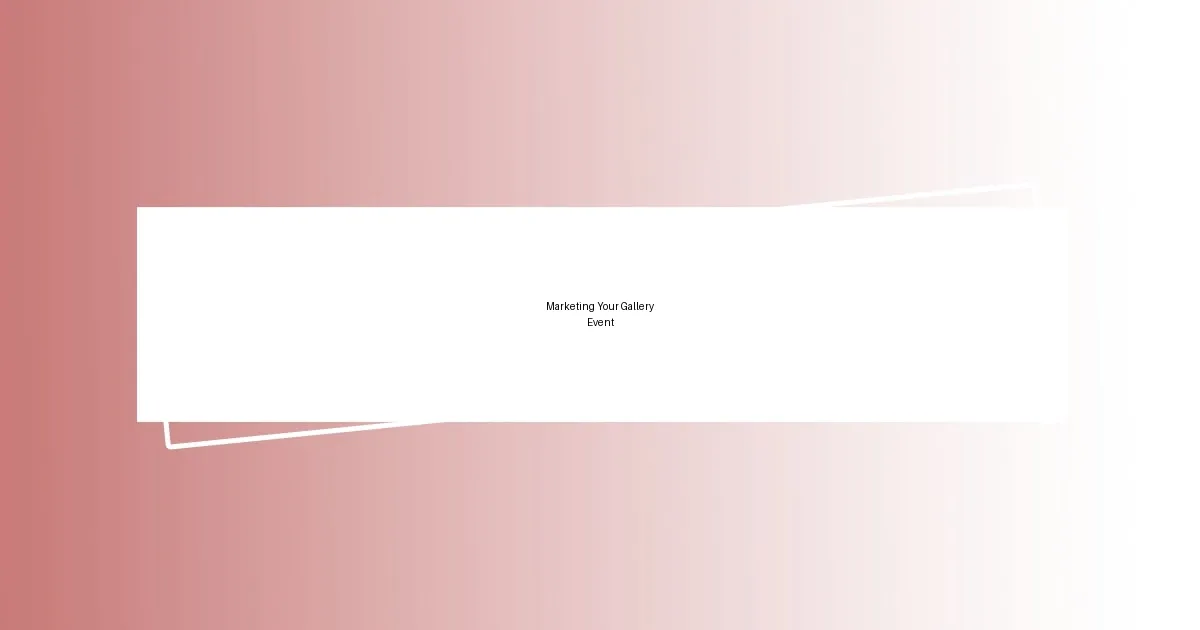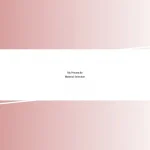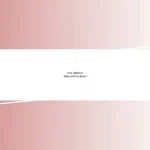Key takeaways:
- Gallery events blend art and community, creating spaces for emotional connections and dialogue between artists and attendees.
- Setting clear short-term and long-term goals is essential for success, focusing on both immediate engagement and future relationships.
- Effective curation involves selecting artworks that resonate with a theme and engage the audience, fostering a cohesive visual experience.
- Post-event evaluation should focus on emotional impact and audience feedback, indicating the lasting significance of the experience beyond just attendance numbers.

Understanding Gallery Events
Gallery events serve as a unique intersection between art and community, where creativity flourishes and connections are made. I still remember the first time I stepped into a gallery opening—not as a guest, but as a curator. The energy in the room was palpable, filled with anticipation and curiosity. Have you ever felt that electric buzz in the air when like-minded individuals gather to appreciate art?
Organizing a gallery event is more than just displaying art; it’s about crafting an experience. In that moment, I realized that each piece tells a story, and it’s my job to weave those stories together into a cohesive narrative. The thrill of curating not only offers an opportunity to showcase talent but also invites dialogue and emotional connections between the artist and the attendees. This underscores a fundamental truth: how can we truly understand art if we don’t engage with it on a personal level?
As I navigated the intricacies of planning my first gallery event, I was struck by how each detail contributes to the overall atmosphere—lighting, music, even the arrangement of the artworks. I found myself wondering, how can something as simple as the placement of a painting significantly alter the viewer’s experience? That’s the beauty of gallery events; they offer a space for transformation and reflection, a chance to see the world through the eyes of the artists we celebrate.

Setting Your Event Goals
Setting clear goals for your gallery event is essential for ensuring its success. I learned this firsthand when I was preparing my first exhibition. I sat down with a cup of coffee, and I thought about what I wanted to achieve. Was it to sell artwork? My answer was no, it was more about creating a community around the art and engaging people on a deeper level.
I found it helpful to outline both short-term and long-term goals. Short-term goals focused on the immediate experience of the event, like maximizing foot traffic and fostering connections. In contrast, long-term goals revolved around building ongoing relationships with attendees and potentially establishing a reputation for future events. This dual approach helped me keep the bigger picture in mind while attending to the details, which can often feel overwhelming.
Lastly, as I reflected on my journey, I realized that goals can evolve. During the event, I discovered new aspects of audience engagement that I hadn’t initially considered. For example, having interactive discussions turned out to be a powerful way to connect with attendees. Adjusting my goals in real-time allowed the event to become a living, breathing space of creativity and conversation.
| Short-term Goals | Long-term Goals |
|---|---|
| Maximize foot traffic | Build ongoing relationships |
| Foster connections among attendees | Establish a reputation for future events |
| Create an engaging atmosphere | Encourage community involvement |

Curating Art for the Event
Curating art for my first event was both exhilarating and daunting. I remember standing in the gallery, surrounded by an eclectic mix of pieces, and feeling an overwhelming sense of responsibility. Each artwork was a representation of the artist’s vision, and my goal was to create a visual conversation that flowed seamlessly throughout the space. It was vital for me to select works that not only complemented each other but also engaged the audience on multiple levels.
Here are some key factors I considered while curating the art:
- Theme Harmony: Each piece had to resonate with the central theme, creating a unified experience.
- Diverse Mediums: I included a mix of paintings, sculptures, and installations to attract different tastes and encourage varied interpretations.
- Artist Representation: Collaborating with emerging artists was essential; their raw talent brought fresh perspectives and vibrancy to the event.
- Flow of Space: I meticulously arranged the artworks to guide visitors naturally through the gallery, enhancing their visual journey.
- Interactive Elements: I added an interactive installation, which invited viewers to participate and left a lasting impression, sparking conversations among attendees.
By blending these elements, I was able to transform the gallery into a dynamic space where emotion and creativity intertwined, creating a memorable experience for everyone involved. I felt a rush of excitement every time I walked through, knowing I was facilitating something much larger—a community celebration of art and connection.

Choosing the Right Venue
Choosing the right venue for my gallery event felt like unearthing a gem in a sea of possibilities. I vividly remember visiting several spaces, each with its unique vibe, and feeling an electric pulse in the ones that resonated with my vision. When I finally stepped into my chosen location, the high ceilings and natural light swept me away—instantly, I envisioned how each piece of art would interact with the space. Have you ever felt that spark during a venue hunt? It’s exhilarating.
I also had to consider practical aspects, like accessibility and capacity. After all, it was essential for potential visitors to feel welcomed and comfortable. I recall a venue that, while stunning, could barely fit a dozen guests. It made me rethink: How could I create an inviting atmosphere if no one could enter? My decision-making process revolved around ensuring that everyone could experience the art without feeling cramped or overwhelmed.
Finally, I paid attention to the surrounding neighborhood. I wanted a space that not only showcased art but also engaged with the community. Selecting a venue in a vibrant area, where art enthusiasts spontaneously wandered by, truly made a difference. I often chat with fellow curators who prioritize foot traffic; it’s not just about the art but creating an intentional environment that thrives beyond the gallery walls. What’s the point of a beautiful event if it’s hidden away?

Marketing Your Gallery Event
Marketing my gallery event was an adventure in itself, requiring creativity and strategic thinking. I can’t stress enough how essential social media was in amplifying my reach. I crafted engaging posts highlighting the artists and their stories. Watching their excitement as they shared my posts felt like an unexpected reward—it turned a simple gallery opening into a collective celebration.
I also leveraged email marketing to reach out to my contacts, inviting them personally to the event. The day before the opening, I experienced a mix of nerves and excitement as I hit “send” knowing that my words and the artwork would soon resonate with eager attendees. Have you ever felt that surge of hope that comes with sharing something you care about? It’s a bit like sending out invitations to a party where you truly want everyone to have a good time.
Another unique tactic I employed was collaboration with local influencers, which really broadened my audience. By inviting them to preview the event, I created a buzz that was palpable. It was thrilling to see their followers engage with the gallery’s story. I recall one influencer posting a live stream—my heart raced as I watched viewers react in real time, excitedly chatting about what they saw. Those moments reinforced my belief that effective marketing is not just about reaching a wider audience, but also about building a vibrant community around the art.

Engaging with Artists and Guests
Engaging with artists and guests at my gallery event was an experience I’ll never forget. I remember a moment when an artist I featured, who was initially nervous about the turnout, started chatting with attendees about their work. Seeing their expressions light up as they connected over shared passions felt like a magic trick—I was witnessing art come to life through conversation. Have you ever seen the spark of inspiration in someone’s eyes? It’s contagious.
During the event, I made it a point to walk around and personally greet guests. I was surprised by how many lively discussions emerged just from asking simple open-ended questions, like, “What caught your eye tonight?” It provided me with insight into what resonated with the audience and deepened their connection to the art and artists present. Some guests even turned to me with admiration in their voices, sharing how they felt inspired to create their own art. It reinforced the idea that engagement goes beyond mere observation; it fosters a sense of community and collaboration.
Another memorable aspect was the post-event feedback I received from both the artists and the guests. People shared how meaningful it was to have a platform where they could not only view art but discuss its significance openly. I recall receiving an email from one guest thanking me for curating an experience that felt intimate and inclusive. It made me reflect—how often do we forget the human element in art? Each interaction during the evening added layers to the experience, creating a community woven together through appreciation, dialogue, and creativity.

Evaluating Your Event Success
Evaluating the success of my gallery event involved more than just counting attendees; it was about assessing the overall impact of the experience. I recall reflecting on the conversations I overheard, especially one guest who passionately shared how an artwork resonated with their personal journey. Moments like these made me realize that the true measure of success is the emotional resonance created during the event.
After the event, I actively sought feedback from both guests and artists. I found it fascinating when one artist told me that they felt validated and inspired by the interest shown in their work. This kind of response is invaluable; it not only highlights the effectiveness of my curation but also lets me know that I’m contributing to the artists’ journeys. Have you ever sensed that your efforts have genuinely made a difference in someone’s life? It’s an indescribable feeling.
I also looked at social media interactions as a gauge of success. The comments and shares on my posts indicated that the artwork sparked conversations long after the event concluded. I remember seeing a post from one guest who shared photos from the gallery, expressing how they felt a deeper connection to art after attending. It’s moments like that which solidify my belief that a successful event isn’t just a one-night affair; it’s the lasting impressions and connections forged that truly matter.














